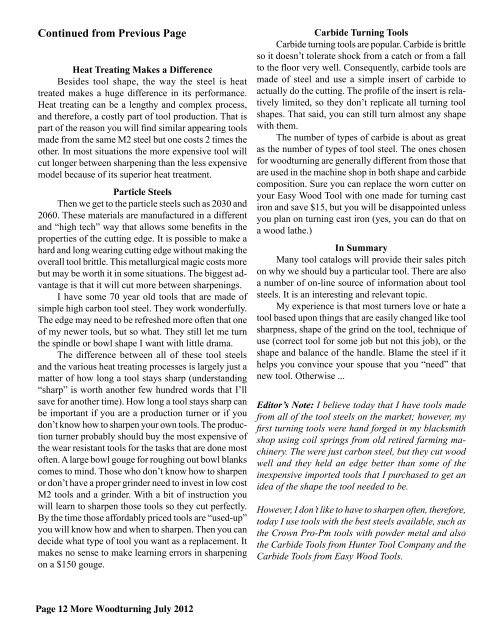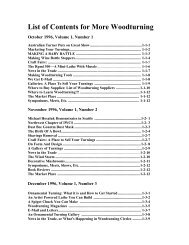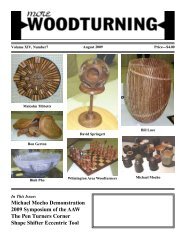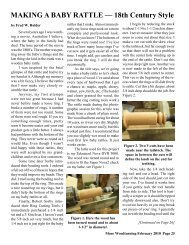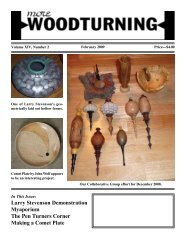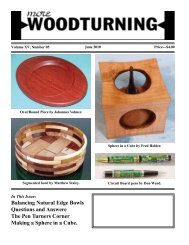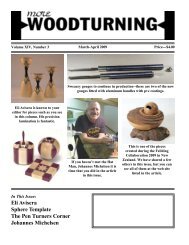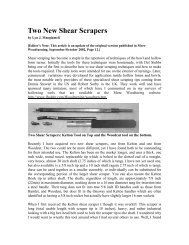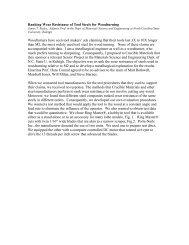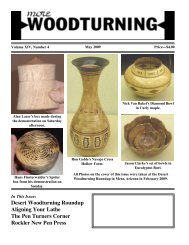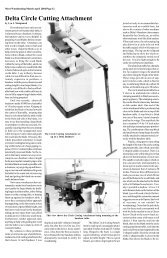Woodturner--Les Roberts The Pen Turners Corner A Terrible Tool ...
Woodturner--Les Roberts The Pen Turners Corner A Terrible Tool ...
Woodturner--Les Roberts The Pen Turners Corner A Terrible Tool ...
Create successful ePaper yourself
Turn your PDF publications into a flip-book with our unique Google optimized e-Paper software.
Continued from Previous PageHeat Treating Makes a DifferenceBesides tool shape, the way the steel is heattreated makes a huge difference in its performance.Heat treating can be a lengthy and complex process,and therefore, a costly part of tool production. That ispart of the reason you will find similar appearing toolsmade from the same M2 steel but one costs 2 times theother. In most situations the more expensive tool willcut longer between sharpening than the less expensivemodel because of its superior heat treatment.Particle Steels<strong>The</strong>n we get to the particle steels such as 2030 and2060. <strong>The</strong>se materials are manufactured in a differentand “high tech” way that allows some benefits in theproperties of the cutting edge. It is possible to make ahard and long wearing cutting edge without making theoverall tool brittle. This metallurgical magic costs morebut may be worth it in some situations. <strong>The</strong> biggest advantageis that it will cut more between sharpenings.I have some 70 year old tools that are made ofsimple high carbon tool steel. <strong>The</strong>y work wonderfully.<strong>The</strong> edge may need to be refreshed more often that oneof my newer tools, but so what. <strong>The</strong>y still let me turnthe spindle or bowl shape I want with little drama.<strong>The</strong> difference between all of these tool steelsand the various heat treating processes is largely just amatter of how long a tool stays sharp (understanding“sharp” is worth another few hundred words that I’llsave for another time). How long a tool stays sharp canbe important if you are a production turner or if youdon’t know how to sharpen your own tools. <strong>The</strong> productionturner probably should buy the most expensive ofthe wear resistant tools for the tasks that are done mostoften. A large bowl gouge for roughing out bowl blankscomes to mind. Those who don’t know how to sharpenor don’t have a proper grinder need to invest in low costM2 tools and a grinder. With a bit of instruction youwill learn to sharpen those tools so they cut perfectly.By the time those affordably priced tools are “used-up”you will know how and when to sharpen. <strong>The</strong>n you candecide what type of tool you want as a replacement. Itmakes no sense to make learning errors in sharpeningon a $150 gouge.Carbide Turning <strong>Tool</strong>sCarbide turning tools are popular. Carbide is brittleso it doesn’t tolerate shock from a catch or from a fallto the floor very well. Consequently, carbide tools aremade of steel and use a simple insert of carbide toactually do the cutting. <strong>The</strong> profile of the insert is relativelylimited, so they don’t replicate all turning toolshapes. That said, you can still turn almost any shapewith them.<strong>The</strong> number of types of carbide is about as greatas the number of types of tool steel. <strong>The</strong> ones chosenfor woodturning are generally different from those thatare used in the machine shop in both shape and carbidecomposition. Sure you can replace the worn cutter onyour Easy Wood <strong>Tool</strong> with one made for turning castiron and save $15, but you will be disappointed unlessyou plan on turning cast iron (yes, you can do that ona wood lathe.)In SummaryMany tool catalogs will provide their sales pitchon why we should buy a particular tool. <strong>The</strong>re are alsoa number of on-line source of information about toolsteels. It is an interesting and relevant topic.My experience is that most turners love or hate atool based upon things that are easily changed like toolsharpness, shape of the grind on the tool, technique ofuse (correct tool for some job but not this job), or theshape and balance of the handle. Blame the steel if ithelps you convince your spouse that you “need” thatnew tool. Otherwise ...Editor’s Note: I believe today that I have tools madefrom all of the tool steels on the market; however, myfirst turning tools were hand forged in my blacksmithshop using coil springs from old retired farming machinery.<strong>The</strong> were just carbon steel, but they cut woodwell and they held an edge better than some of theinexpensive imported tools that I purchased to get anidea of the shape the tool needed to be.However, I don’t like to have to sharpen often, therefore,today I use tools with the best steels available, such asthe Crown Pro-Pm tools with powder metal and alsothe Carbide <strong>Tool</strong>s from Hunter <strong>Tool</strong> Company and theCarbide <strong>Tool</strong>s from Easy Wood <strong>Tool</strong>s.Page 12 More Woodturning July 2012


